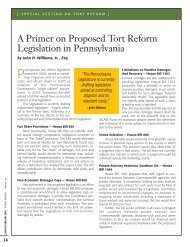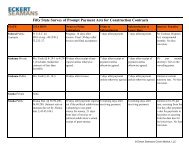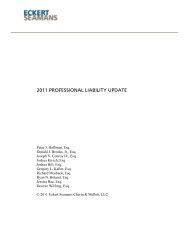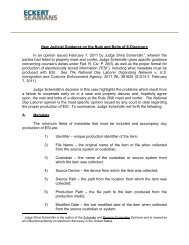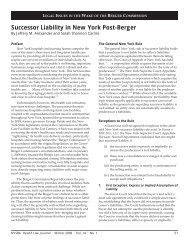(b) the utility of the defendant’s conduct, (c) the nature and forseeability of the given risk,(d) the consequences of imposing the duty, and (e) the overall public interest in imposing agiven duty – the factors weighed against the creation of duty. Notably, the Court indicated,in varying with the Superior Court’s decision in Elias v. Lancaster Gen. Hosp., 710 A.2d 65(Pa. Super. 1998), that not even a special relationship can serve to give rise to a cause ofaction for negligent spoliation. Pyeritz at *18.3. Zaleppa v. Seiwell, 2010 Pa. Super. 208 (Pa. Super. Ct. 2010)In Zaleppa v. Seiwell, the court held that the Medicare Secondary Payer Act (“MSPA”)allows only the United States government to recover outstanding conditional Medicarepayments, and that private entities may not file lawsuits on behalf of the government. InZaleppa, the trial court returned a verdict against the defendant to a car accident suit. Thedefendant filed a post-trial motion, which the trial court denied, to include not only Zaleppa, butalso Medicare, as payees when satisfying her verdict, because, she claimed, the MSPA requiresparties to litigation to protect Medicare’s interests.The Superior Court, in reviewing the defendant’s appeal of the trial court’s denial of thepost-trial motion, answered the question of “whether the MSPA either requires or allows aprivate entity to assert the rights of the United States government regarding a potential claim forreimbursement of a Medicare lien.” The court found that the express language of the MSPAimposes a duty on the primary insurance plan to reimburse Medicare for payments Medicaremade that the primary insurer was actually responsible for. The primary insurance plan’s dutyonly arises after Medicare issues a recovery demand letter. The court found that only afterissuing this demand letter may the United States government, and only the United Statesgovernment, bring an action for the reimbursement. A primary plan cannot assert Medicare’sright to reimbursement to guard itself against future liability to Medicare.VIII. LEGAL MALPRACTICEA. Elements of a Cause of Action for Legal Malpractice – NegligenceIn Kituskie v. Corbman, 714 A.2d 1027 (Pa. 1998), the Supreme Court reiterated theelements for a cause of action for legal malpractice based on negligence in Pennsylvania. Theyare as follows: (1) employment of the attorney or other basis for a duty; (2) the failure of theattorney to exercise ordinary skill and knowledge; and (3) that such negligence was theproximate cause of the damage to Plaintiff. The court went on to state that Plaintiffs must provethat they had a viable cause of action against the party they wished to sue in the underlyingaction and that the attorney they hired was negligent in prosecuting or defending that underlyingcase. Thus, the court noted, Plaintiffs must prove “a case-within-a-case” in that they mustinitially establish by a preponderance of the evidence that they would have recovered a judgmentin the underlying action. Consequently,[i]t is only after the Plaintiff proves he would have recovereda judgment in the underlying action that the Plaintiff can thenproceed with proof that the attorney he engaged to prosecute ordefend the underlying action was negligent in the handling of the144
underlying action and that such negligence was the proximatecause of the Plaintiff’s loss since it prevented the Plaintiff frombeing properly compensated for his loss.Id. at 1030; see also Still v. Saul Ewing, L.L.P., No. 3737, 2009 Phila. Ct. Com. Pl. LEXIS 190(Phila. Cty. Ct. Com. Pl. Sept. 10, 2009) (granting summary judgment when plaintiff did nothave a viable cause of action at the time he was represented by Defendants); Weller v. Ransom-Garner, No. 05-cv-2758, 2008 U.S. Dist. LEXIS 49953 (E.D. Pa. June 27, 2008) (grantingsummary judgment where Plaintiff fails to provide any support beyond speculation, conclusoryallegations and mere denials for contention that trial judge would have reached differentconclusion had attorney-Defendants acted differently); aff’d, 338 Fed. Appx. 249 (3d Cir. 2009)(not precedential); Garland v. U.S. Airways, Inc., No. 05-140, 2006 WL 2927271 (W.D. Pa.2006) (under first prong of legal malpractice test, no duty owed by attorney to adverse party),reconsideration denied, 2007 WL 433178 (W.D. Pa. 2007), aff’d, 270 Fed. Appx. 99 (3d Cir.2008) (not precedential), cert. denied, 129 S.Ct. 125 (2008); CBC Innovis, INC. v. Federman &Phelan,LLP, No. 4147, 2009 Phila. Ct. Com. Pl. LEXIS 50 (Phila. Cty. Ct. Com. Pl. Feb. 18,2009) (defendant attorney did not owe a duty to confirm payoff data provided by Plaintiff inconnection with a foreclosure action), aff’d, 11 A.3d 1022 (Pa. Super. Ct. 2010); WindwardAgency, Inc. v. Russell, No. 3333, 2009 Phila Ct. Com. Pl. LEXIS 196 (Phila. Cty. Ct. Com. Pl.Oct. 1, 2009), aff’d, 11 A.3d 1035 (Pa. Super. 2010), pet. for allowance of app. denied, 23 A.3d542 (Pa. 2011) (foregoing the right to name an arbitrator and losing all right to participate innaming a neutral arbitrator is clearly below the professional standard of care).In Stacey v. City of Hermitage, 02-Cv-1911, 2008 WL 941642 (W.D. Pa. 2008), thecourt set forth the requirements for establishing a legal malpractice claim and discussed whetherPlaintiff’s allegations regarding breach and causation were legally sufficient. The court statedthere must be “proof of actual loss rather than a breach of a professional duty causing onlynominal damages, speculative harm or the threat of future harm.” (quoting Kituskie v.Corbmanu, 714 A.2d at 1030). The only reference to legal malpractice in Plaintiffs’ AmendedComplaint stated “[b]ecause of the actions and omissions of the ‘malpractice’ Defendants(Attorney Ferry and his firm Watts & Pepicelli, and Attorney Cartwright) injured their respectiveclients … Plaintiff seek damages for those injuries.”The court characterized Plaintiff’s allegations as bare and conclusory and found theywere not sufficient facts pled regarding a failure to exercise ordinary professional skill andknowledge. The court also explained the failure to file a complaint, without more “may be‘consistent with’ wrongful conduct, but it is not ‘suggestive’ of misconduct.” (quoting BellAtlantic Corp v. Twombly, 550 U.S. 554 (2007)). The court further noted that a failure to file acomplaint is not suggestive of misconduct because attorneys have an independent professionalobligation to undertake a reasonable investigation prior to filing suit and to avoid filing frivolousclaims. The court found that there were no allegations to satisfy the causation requirement, asPlaintiff did not allege how the attorneys’ alleged breach caused any actual loss. The court alsonoted that Plaintiff could not avoid the two year statute of limitations for negligence actions bycharacterizing the negligence action as a breach of contract action.A notable case regarding a plaintiff’s burden to prove a “case within a case” is Barcola v.Hourigan, Kluger & Quinn, 82 Pa. D. & C. 4th 394 (Lackawanna Cty. Ct. Com. Pl. Dec. 29,145
- Page 3 and 4:
EMTALA CASES ......................
- Page 5:
Filing an Affidavit of Non-Involvem
- Page 8 and 9:
II.PROFESSIONAL LIABILITY - AN OVER
- Page 10 and 11:
The Superior Court reversed the tri
- Page 12 and 13:
to a third party pursuant to the st
- Page 14 and 15:
After approximately five months, De
- Page 16 and 17:
learned the day after the surgery t
- Page 18 and 19:
conduct to the delay in colon cance
- Page 20 and 21:
court admitted the expert’s testi
- Page 22 and 23:
(b)(c)other reasonable causes, incl
- Page 24 and 25:
corroborated his testimony. The cou
- Page 26 and 27:
husband’s estate. Plaintiff alleg
- Page 28 and 29:
Other notable federal cases arising
- Page 30 and 31:
The Superior Court found that in re
- Page 32 and 33:
§ 1303.512(b). The court, however,
- Page 34 and 35:
In Neidig v. United States, No. 07-
- Page 36 and 37:
Additionally, the Supreme Court not
- Page 38 and 39:
were not indicated for her conditio
- Page 40 and 41:
surgeon is the same as it would be
- Page 42 and 43:
It should be noted that the Superio
- Page 44 and 45:
Finally, the court held that the tr
- Page 46 and 47:
The Supreme Court of Pennsylvania r
- Page 48 and 49:
nurses deviating from applicable st
- Page 50 and 51:
certainty, the court reviews expert
- Page 52 and 53:
Under Pennsylvania law, the Court n
- Page 54 and 55:
testimony, Defendant presented his
- Page 56 and 57:
Following Cooper v. Roberts, 286 A.
- Page 58 and 59:
Plaintiff developed chronic diarrhe
- Page 60 and 61:
where payment is made by Medicaid w
- Page 62 and 63:
accomplished. In Valles v. Albert E
- Page 64 and 65:
In 1980, the Pennsylvania Superior
- Page 66 and 67:
Plaintiff had a routine monitoring
- Page 68 and 69:
Plaintiff’s Contract ClaimsThe Co
- Page 70 and 71:
is a failure to report changes in a
- Page 72 and 73:
unit to assure post-surgical patien
- Page 74 and 75:
sliced his wrist and arm with a raz
- Page 76 and 77:
licensed professionals for whom the
- Page 78 and 79:
(c)Limitations of Corporate Neglige
- Page 80 and 81:
Even more recently, our Superior Co
- Page 82 and 83:
(a)HMO IssuesIn McClellan v. Health
- Page 84 and 85:
affidavit submitted by Defendants o
- Page 86 and 87:
treatments while at VA’s faciliti
- Page 88 and 89:
[s]ubstantively, we believe that a
- Page 90 and 91:
The party claiming the benefit of t
- Page 92 and 93:
deprive (him) of civil rights guara
- Page 94 and 95:
found that the District Court was w
- Page 96 and 97:
With respect to fraudulent concealm
- Page 98 and 99:
would be applied in situations wher
- Page 100 and 101: they had not raised them in the cou
- Page 102 and 103: (a)Informed ConsentUnder MCARE, a p
- Page 104 and 105: civil enforcement provisions and ma
- Page 106 and 107: MCARE also changes the manner in wh
- Page 108 and 109: whose death, in 2005, was allegedly
- Page 110 and 111: vicariously liable if the plaintiff
- Page 112 and 113: health center or its equivalent or
- Page 114 and 115: In Pennsylvania Medical Society, th
- Page 116 and 117: to any professional who is alleged
- Page 118 and 119: Since the 2005 amendments, there ha
- Page 120 and 121: ule, but who intentionally ignores
- Page 122 and 123: the original Complaint was delivere
- Page 124 and 125: foreclose all challenges against th
- Page 126 and 127: number of boxes), which was support
- Page 128 and 129: questions of professional judgment
- Page 130 and 131: deviated from any professional stan
- Page 132 and 133: The Third Circuit affirmed the Dist
- Page 134 and 135: claims and cross-claims remain agai
- Page 136 and 137: By an Amendatory Order dated March
- Page 138 and 139: The court acknowledged that there i
- Page 140 and 141: apply and that the trial court misa
- Page 142 and 143: Barbados had enough litigation-spec
- Page 144 and 145: E. Preemption of Vaccine Design Def
- Page 146 and 147: 2. Pa. R. Civ. Pro. 1036.1 - Reinst
- Page 148 and 149: Barrick, at *34-35.Furthermore, the
- Page 152 and 153: 2006). In this case, Plaintiffs bro
- Page 154 and 155: B. Elements of a Cause of Action fo
- Page 156 and 157: decision in Muhammad precluded Mr.
- Page 158 and 159: considered speculative “only if t
- Page 160 and 161: underlying cause of action involved
- Page 162 and 163: In Capital Care Corp., the Superior
- Page 164 and 165: The court found, however, to state
- Page 166 and 167: of reasonable diligence. The standa
- Page 168 and 169: not be set aside. On July 7, 2005,
- Page 170 and 171: complete bar to recovery. Since a l
- Page 172 and 173: On appeal, Plaintiffs claimed that
- Page 174 and 175: In Liggon-Redding, 659 F.3d at 265,
- Page 176 and 177: elieved of those minimum standards
- Page 178 and 179: elevant to the proceedings, the com
- Page 180 and 181: establish professional misconduct b
- Page 182 and 183: Upholding the Superior Court’s Or
- Page 184 and 185: Id.Rejecting revocation and suspens
- Page 186 and 187: order as a sanction under Rule 4019
- Page 188: {1009912]182




